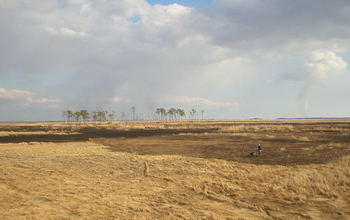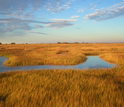News Release 13-197
Wetlands' ability to overcome sea level rise threatened
When do wetlands reach their limit, and how are we lowering that point?

On this tidal marsh in Chesapeake Bay, wetlands and people have co-existed for millennia.
December 4, 2013
This material is available primarily for archival purposes. Telephone numbers or other contact information may be out of date; please see current contact information at media contacts.
Left to themselves, coastal wetlands can resist rapid sea level rise.
But humans could be sabotaging some of wetlands' best defenses, according to results published in this week's issue of the journal Nature.
Thanks to an intricate system of feedbacks, wetlands are remarkably good at building up soils to outpace sea level rise. The questions are: When do they reach their limit, and how have we lowered that point?
Without human-caused climate change, "we wouldn't be worried about wetlands surviving the rates of sea level rise we're seeing today," says lead paper author Matthew Kirwan of the Virginia Institute of Marine Science and the National Science Foundation (NSF) Virginia Coast Reserve Long-Term Ecological Research (LTER) site.
Virginia Coast Reserve is one of 26 such NSF LTER sites around the globe in ecosystems from deserts to mountains and marshes to grasslands.
In an unchanged world, "wetlands would build vertically at faster rates," says Kirwan, "or move inland to higher elevations."
The paper's co-author is Patrick Megonigal of the Smithsonian Environmental Research Center.
A wetland is land that's saturated with water, whether permanently or seasonally. The water found in wetlands can be saltwater, freshwater or brackish water. Main wetland types include swamps, marshes, bogs and fens.
Wetlands have developed several ways to build elevation to keep from drowning.
Aboveground, tidal flooding provides one of the biggest assists. When marshes flood during high tides, sediment settles out of the water, adding new soil. As sea level rises and flooding occurs more often, marshes react by building soil faster.
Belowground, the growth and decay of plant roots add organic matter.
Even erosion can work in wetlands' favor, as sediment lost at one marsh may be deposited in another. While a particular wetland may lose ground, the total wetland area may remain unchanged.
But, if a wetland becomes so submerged that its vegetation dies off, these "positive feedback loops" are lost. Similarly, if sediment delivery to a wetland is cut off, that wetland can no longer build soil to outpace rising seas.
"This study reveals the complex, long-term interplay among processes that maintain coastal wetlands in the face of sea level rise," says Saran Twombly, program director in NSF's Division of Environmental Biology, which funds the NSF Virginia Coast Reserve LTER site.
"Humans are newcomers to this delicate balance. The future of a habitat so essential to human well-being depends on how severely we alter it."
For example, groundwater withdrawal and artificial drainage can cause the land to sink, as is happening in Chesapeake Bay.
Because of this subsidence, eight of the world's 20 largest coastal cities have relative sea level rise greater than climate change projections.
Dams and reservoirs also prevent 20 percent of the global sediment load from reaching the coast.
Marshes on the Yangtze River Delta, for example, have survived a relative sea level rise of more than 50 millimeters per year since the 7th century--until the recent building of more than 50,000 dams cut off the supply of sediment and accelerated erosion.
"Tidal marshes are amazing ecosystem engineers that can raise themselves upward if they remain healthy, especially if there is sediment in the water," says Megonigal.
"We know there are limits, however. Those limits are changing as people alter the environment."
-NSF-
-
Scientist Matthew Kirwan conducts field research in Chesapeake Bay wetlands.
Credit and Larger Version -
Salt marsh "dissected" by a tidal creek at NSF's Plum Island Ecosystems LTER site in Massachusetts.
Credit and Larger Version -
High-elevation marsh at the Plum Island Ecosystems LTER site; flood-tolerant vegetation rules.
Credit and Larger Version -
A fishing camp along Falgout Canal Bayou, La., where marsh has been flooded by seawater.
Credit and Larger Version -
Some Massachusetts marshes formed after European settlement; deforestation increased sedimentation.
Credit and Larger Version
Media Contacts
Cheryl Dybas, NSF, (703) 292-7734, email: cdybas@nsf.gov
Dave Malmquist, Virginia Institute of Marine Science, (804) 684-7011, email: davem@vims.edu
Kristen Minogue, Smithsonian Environmental Research Center, (443) 482-2325, email: minoguek@si.edu
Related Websites
NSF Long-Term Ecological Research Network: http://www.lternet.edu
NSF Virginia Coast Reserve LTER Site: http://www.lternet.edu/sites/vcr
NSF Publication: Discoveries in Long-Term Ecological Research: http://www.nsf.gov/pubs/2013/nsf13083/nsf13083.pdf?WT.mc_id=USNSF_25&WT.mc_ev=click
The U.S. National Science Foundation propels the nation forward by advancing fundamental research in all fields of science and engineering. NSF supports research and people by providing facilities, instruments and funding to support their ingenuity and sustain the U.S. as a global leader in research and innovation. With a fiscal year 2023 budget of $9.5 billion, NSF funds reach all 50 states through grants to nearly 2,000 colleges, universities and institutions. Each year, NSF receives more than 40,000 competitive proposals and makes about 11,000 new awards. Those awards include support for cooperative research with industry, Arctic and Antarctic research and operations, and U.S. participation in international scientific efforts.
Connect with us online
NSF website: nsf.gov
NSF News: nsf.gov/news
For News Media: nsf.gov/news/newsroom
Statistics: nsf.gov/statistics/
Awards database: nsf.gov/awardsearch/
Follow us on social
Twitter: twitter.com/NSF
Facebook: facebook.com/US.NSF
Instagram: instagram.com/nsfgov







